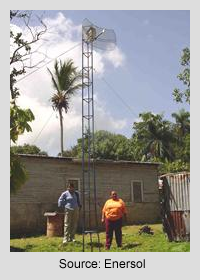Dominican Republic - WiFi
Home > RESOURCES > Case Studies > Latin America & Caribbean > Dominican Republic - WiFi
In 2002, Enersol’s EduSol program in the Dominican Republic (DR) worked with District Office 16 of the Ministry of Education to provide Internet access to three remote schools in the Sánchez Ramírez province. The project centered on the rural community of Comedero, where the local high school operated a VSAT connection to the Internet. With 15 computers sharing a 4 Mbps downlink, the available satellite bandwidth was substantially underutilized. The solution that Enersol selected employed 802.11b wireless networking technology at 2.4 GHz (WiFi) to connect the remote schools to the VSAT connection at Comedero high school. There were few other data connectivity options to consider. The cost of a VSAT installation for each school was prohibitive. Analog cellular offered a maximum connection speed of 4.8 bps, suitable for email but not fascimile or browsing the Internet. By comparison, the WiFi setup that was selected permitted students in the remote schools to connect to the internet at 90 kbps, close to twice the speed of a typical urban dial-up connection. The wireless network consisted of a Cisco Aeronet 350 Access Point (AP) installed at the high school, a second AP installed as a repeater, and three wireless Cisco Workgroup Bridges installed at each of the remote schools. High-gain, 25 dB parabolic antennas, one of which is shown in the picture at right, were installed at the remote schools and a 14 dB antenna was used at the high school. Although all three schools were located within a four-kilometer radius of the high school, the repeater was needed to reach one school which did not have a line of sight to Comedero. Each remote school received two laptop computers and a 4-port ethernet hub, which were wired to the Workgroup Bridge. Except for the AP at the high school, which had grid electricity, the power requirements of the wireless nodes were met by solar PV systems. Each node required only 5-6 W of power to operate. Power was delivered from the PV systems to the Workgroup Bridges over the Ethernet cables. The repeater was installed with its own 24-hour remote power system despite concerns that both would be at risk of theft. The repeater sits on a water tank set on a hill 0.5 km from the high school (see photo below). It has a 24 V Access Point (AP), set in repeater mode, which is powered by a PV module of 40 W. A controller of 10 A and a lightning arrestor are installed in a lockbox to protect against damage to the installation. Each school is 1.6 to 3.2 km from the tank. Using the AP in repeater mode does reduce data throughput to 5 Mbps, but is not a constraint in this configuration since the bandwidth of the VSAT satellite connection is lower. While the strategy provided significant savings on the upfront and ongoing costs, there were also risks to this approach. The need to invest in an independent VSAT was avoided by clustering the project sites next to a facility with existing Internet service. This saved roughly US$4,000 in the upfront investment. The schools were also able to save on ongoing costs for bandwidth, estimated at US$150-300 per month, because the government had a 10-year contract with a national telecommunications provider. However, this arrangement also has institutional risks. The high school’s service has been interrupted due to contractual issues between the service provider and the Ministry of Education. Similarly, the electrical service from the grid that powers the VSAT in Comedero proved to be extremely unreliable, and it took several months for the Ministry’s contractors to configure the backup power systems (diesel genset and inverter) so that they would work with the VSAT. The overall investment was roughly US$10,000. Equipment (57%) and international labor (28%) accounted for most of the total, with 14% for local labor and fuel. The cost of the installation at the high school was roughly US$2,000, of which the major components were the Access Point (51%) and international labor and travel (22%). The repeater was the most costly node at roughly US$2,700, 70% of which is accounted for by the AP350, international labor and travel, and PV equipment. The cost of the client schools varied due to the need for towers in two locations to achieve line-of-sight with the repeater. Where a 20-foot tower was needed the cost was US$1,900 versus US$1,570 without. The cost for a rural network with the same physical characteristics could be reduced to US$6,500-7,500 by relying more heavily on Dominican contractors, who have moved up the learning curve, and by saving on equipment costs. Rural wireless LANs are still emerging in the DR. Before the project virtually no technicians outside of the capital had the knowledge to design and build networks. Now the use of the expatriate expert could be restricted to design and quality control, with most fieldwork done by a local radio communications entrepreneur. Similarly, equipment costs would fall by roughly US$1,100 due to heavy cost cutting by Cisco and other equipment manufacturers on the WiFi units since 2002. However, it should also be noted that the radios and antennas were hand-carried into the DR. Under conventional arrangements it is possible that a 36% tax might be assessed, which would have increased costs by US$1,250-1,500. Related Web-based Resources
|
